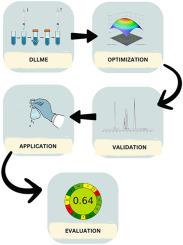Sustainable dispersive liquid-liquid microextraction optimized by response surface methodology for multiclass emerging contaminants in surface water
IF 5.8
2区 化学
Q2 CHEMISTRY, MULTIDISCIPLINARY
引用次数: 0
Abstract
A green and efficient analytical method was developed for the simultaneous determination of 22 multiclass emerging contaminants (ECs) in surface water using dispersive liquid-liquid microextraction (DLLME) coupled with chromatographic analysis. Targeted compounds include pharmaceuticals, endocrine-disrupting chemicals (EDCs), pesticides, and perfluoroalkyl substances (PFAS), which are rarely addressed collectively in a single DLLME workflow. The method was optimized using Response Surface Methodology (RSM), enabling the robust modelling of parameter interactions with reduced experimental runs. Environmentally benign, low-toxicity solvents were selected to enhance the greenness of the method without compromising extraction performance. The method exhibited satisfactory performance, including low detection limits reaching up to 0.01 ng/mL range and good repeatability. Its environmental sustainability, assessed via the AGREE metric, yielded a high score of 0.64 versus 0.43 for conventional approaches, validating its alignment with Green Analytical Chemistry (GAC) principles. Application to real surface water samples confirmed its effectiveness for the comprehensive, green monitoring of trace-level ECs in aquatic environments.

响应面法优化地表水中多类新发污染物的液液分散微萃取
建立了一种同时测定地表水中22种多类新兴污染物(ECs)的绿色高效的分散液液微萃取(DLLME)色谱分析方法。目标化合物包括药物、内分泌干扰化学物质(EDCs)、农药和全氟烷基物质(PFAS),这些化合物很少在单个DLLME工作流程中被集中处理。采用响应面法(RSM)对该方法进行了优化,在减少实验运行次数的情况下,实现了参数相互作用的鲁棒建模。环境友好,低毒溶剂的选择,以提高绿色的方法,而不影响提取性能。该方法检测限低,可达0.01 ng/mL,重复性好。通过AGREE指标进行评估,其环境可持续性得分为0.64,而传统方法的得分为0.43,验证了其与绿色分析化学(GAC)原则的一致性。实际地表水样品的应用验证了该方法对水生环境中痕量ECs的综合、绿色监测的有效性。
本文章由计算机程序翻译,如有差异,请以英文原文为准。
求助全文
约1分钟内获得全文
求助全文
来源期刊

Sustainable Chemistry and Pharmacy
Environmental Science-Pollution
CiteScore
8.20
自引率
6.70%
发文量
274
审稿时长
37 days
期刊介绍:
Sustainable Chemistry and Pharmacy publishes research that is related to chemistry, pharmacy and sustainability science in a forward oriented manner. It provides a unique forum for the publication of innovative research on the intersection and overlap of chemistry and pharmacy on the one hand and sustainability on the other hand. This includes contributions related to increasing sustainability of chemistry and pharmaceutical science and industries itself as well as their products in relation to the contribution of these to sustainability itself. As an interdisciplinary and transdisciplinary journal it addresses all sustainability related issues along the life cycle of chemical and pharmaceutical products form resource related topics until the end of life of products. This includes not only natural science based approaches and issues but also from humanities, social science and economics as far as they are dealing with sustainability related to chemistry and pharmacy. Sustainable Chemistry and Pharmacy aims at bridging between disciplines as well as developing and developed countries.
 求助内容:
求助内容: 应助结果提醒方式:
应助结果提醒方式:


